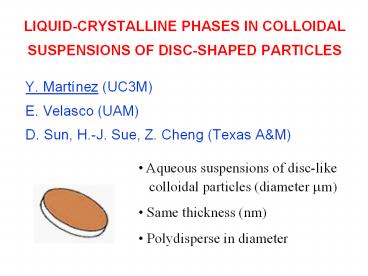LIQUID-CRYSTALLINE PHASES IN COLLOIDAL SUSPENSIONS OF DISC-SHAPED PARTICLES - PowerPoint PPT Presentation
1 / 23
Title:
LIQUID-CRYSTALLINE PHASES IN COLLOIDAL SUSPENSIONS OF DISC-SHAPED PARTICLES
Description:
... In gibbsite Small Angle X-ray scattering NEMATIC SMECTIC large ... LIQUID-CRYSTALLINE PHASES IN COLLODIAL SUSPENSIONS OF DISC-SHAPED PARTICLES Author: – PowerPoint PPT presentation
Number of Views:113
Avg rating:3.0/5.0
Title: LIQUID-CRYSTALLINE PHASES IN COLLOIDAL SUSPENSIONS OF DISC-SHAPED PARTICLES
1
LIQUID-CRYSTALLINE PHASES IN COLLOIDAL
SUSPENSIONS OF DISC-SHAPED PARTICLES
- Y. Martínez (UC3M)
- E. Velasco (UAM)
- D. Sun, H.-J. Sue, Z. Cheng (Texas AM)
- Aqueous suspensions of disc-like
- colloidal particles (diameter mm)
- Same thickness (nm)
- Polydisperse in diameter
2
Anisotropic colloids
discotic colloids
Non-spherical colloidal particles (at least in
one dimension)
Give rise to mesophases
rod-like (prolate)
disc-like (oblate)
- ORIENTED PHASES
- PARTIAL SPATIAL ORDER
rods prefer smectic discs prefer columnar
But there is another factor
POLYDISPERSITY
3
But all synthetic colloids are to some extent
polydisperse in size
parent phase
coexisting phases
FRACTIONATION
polydispersity parameter
Polydispersity could destabilise non-uniform
phases, since it is difficult to accommodate
range of diameters in an ordered arrangement
4
- Effect of polydispersity in discotics
- thickness polydispersity destabilization of
smectic - diameter polydispersity destabilization of
columnar
smectic phase
columnar phase
5
Gibbsite platelets in toluene a hard-disc
colloidal suspension
van der Kooij et al., Nature (2000)
Platelets made of gibbsite a-Al(OH)3
200nm
"hard" platelet
steric stabilisation with polyisobutylene (PIB)
(C4H8)n
Suspensions between crossed polarisers
f0.19 0.28 0.41 0.47 0.45
IN N NC C C
before fractionation dR25
after fractionation dR17
(without polarisers)
6
GEL
14
18
SMECTIC?
dR17
dR25
phase sequence I-N-C
f platelet volume fraction
of monodisperse discs with ltLgt and ltRgt
- But what happens at higher/lower diameter
polydispersity? - Can the smectic phase be stable?
- Role of thickness polydispersity?
7
Zirconium phosphate platelets
a-Zr(HPO4)2 H2O
TEM of pristine a-ZrP platelets
TEM of a-ZrP platelet coated with TBA
8
PROCESS OF EXFOLIATION OF LAYERED a-Zr(HPO4)2H2O
aspect ratio
- diameter optical lengths
- COLUMNAR
- thickness X rays
- SMECTIC
9
Optical images white light and crossed
polarisers
I IN N
NS
f platelet volume fraction
volume occupied by platelets
total volume
10
ISOTROPIC-NEMATIC phase transition
I
I N
N
non-linearity in the two-phase region some
fractionation
extremely large volume-fraction gap
dR
In gibbsite
11
Small Angle X-ray scattering
smectic order, with weak N to S transition
sharp peaks with higher-order reflections
(well-defined layers)
large variation in smectic period with f (almost
factor 3) long-range forces?
SMECTIC
NEMATIC
12
Isotropic-nematic
Restricted-orientation approximation
Distribution projected on Cartesian axes
where is a Schultz distribution
characterised by dR
Hard interactions treated at the excluded-volume
level (Onsager or second-virial theory)
minimum
13
f
dR
dR
CHARACTERISTICS OF SMECTIC PHASE FROM EXPERIMENT
14
Nematic-smectic-columnar
Fundamental-measure theory for polydisperse
parallel cylinders
Second-virial theory not expected to perform well
complicated distribution function
perfect order
Simplifying assumption
SMECTIC
COLUMNAR
number of particles at r in a volume d3r with
diameter between D and DdD
15
dR0.52
dR
fS0.452
fS0.452
16
(No Transcript)
17
Attractive polydisperse platelets
free-energy functional
L
18
Phase diagrams (Gaussian tail distribution)
l 2
l 1
dR 0.294
19
Microfractionation in the coexisting smectic
phase
dR 0.294, l 2, be 1.665
20
Future work
- Improve and extend experiments
- larger range of polydispersities (in particular
lower) - overcome relaxation problems
- Improve and extend theory. Include polydispersity
in both diameter and thickness - Terminal polydispersities in diameter (columnar)
- and thickness (smectic)?
- Better understanding of platelet interactions
- better modelling of interactions
21
- THE END
22
CHARACTERISTICS OF SMECTIC PHASE FROM EXPERIMENT
23
pair potential
Theory some ideas
Potential energy
will contain short-range
repulsive contributions soft interactions (vdW,
electrostatic, solvent-mediated forces,...?)
We treat soft interactions via an effective
thickness Leff (f) of hard discs
- Criteria
- fIN in correct range
- in smectic phase
- approximate theory of screened
- Coulomb interactions?































